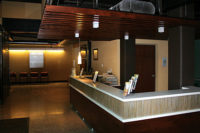Healthy Plaster
Recent building project at Arizona State University building in focuses on sustainability and the use of healthier materials to benefit the students and staff.
 This is
one sustainable renovation that is built with energy efficient materials,
timeless design and healthy alternatives. Located in Tempe, Ariz., this
renovation is the Health Services Building on the Arizona State University
Tempe campus. The new health center consists of innovative materials that
contribute to a healthier environment, increase energy efficiency, and provide
sustainability for the future. The ASU Health Services building will be
completed in March 2012.
This is
one sustainable renovation that is built with energy efficient materials,
timeless design and healthy alternatives. Located in Tempe, Ariz., this
renovation is the Health Services Building on the Arizona State University
Tempe campus. The new health center consists of innovative materials that
contribute to a healthier environment, increase energy efficiency, and provide
sustainability for the future. The ASU Health Services building will be
completed in March 2012.
The use of sustainable design has been increasing among renovations and projects around the globe. Using materials that increase healthy air quality and energy efficiency is a benefit today, as well as in the future. The ASU Health Services building aims to provide students with the highest quality medical services in an environment where they can relax and experience the comfort provided by materials designed to support better health.
 According to the sustainable design review for ASU renovations,
“ASU is committed to advancing sustainable design through new construction or
renovations of the campus.” The new health center focuses on creating an
inviting and healthy space that complements the historic campus and provides
students with a functional space to receive health care. The use of healthier
alternative building materials in this project creates an atmosphere free of
chemicals, toxic substances and particles in the air that can contribute to
allergies, asthma, and other health concerns. An important goal for this
project is to have patients who are satisfied that they receive care from a facility
that strives to create a healthier atmosphere.
According to the sustainable design review for ASU renovations,
“ASU is committed to advancing sustainable design through new construction or
renovations of the campus.” The new health center focuses on creating an
inviting and healthy space that complements the historic campus and provides
students with a functional space to receive health care. The use of healthier
alternative building materials in this project creates an atmosphere free of
chemicals, toxic substances and particles in the air that can contribute to
allergies, asthma, and other health concerns. An important goal for this
project is to have patients who are satisfied that they receive care from a facility
that strives to create a healthier atmosphere.
HEALTHY CONTENT
With the help of Okland Construction and Division Nine Contracting, the new health center contains renewable resources with high recycled content. In addition, the indoor spaces provide zero carbon emissions with zero volatile organic compounds. For the walls of the health center, the interior designer from Orcutt Winslow, Amy Garcia, selected American Clay Earth Plasters from the American Clay Showroom of Construction Solutions Company in Scottsdale, Ariz. American Clay Earth Plasters met ASU’s intent to provide a healthier, sustainable solution to creating naturally beautiful interior walls.
Some of the benefits of using American Clay Earth Plasters are reparability and breathability. With breathable walls, humidity levels remain at an optimal level and mold growth is precluded. Thus, ASU has achieved an interior space that includes an easy-to-repair natural wall covering that should last approximately 50 years.
Dr. Jo M. Knatz, section chief of women’s health at ASU, has already seen an improvement in the way students feel as they enter a newly renovated building.
 “I can say that coming into a new building and not being
accosted with all the new smells was terrific,” Knatz says. “We have many
students with asthma, and they have appreciated coming in and not having a
reaction, different from their experiences with new apartment complexes, for
example. There is natural warmth to the clay, and as a consumer, I love it.”
“I can say that coming into a new building and not being
accosted with all the new smells was terrific,” Knatz says. “We have many
students with asthma, and they have appreciated coming in and not having a
reaction, different from their experiences with new apartment complexes, for
example. There is natural warmth to the clay, and as a consumer, I love it.”
SUSTAINABILITY TRENDS
The interior spaces of the building are now renovated to have low embodied energy and emit no harmful chemicals into the air, allowing the area to achieve optimum air quality. Along with enhancing the interior environment, outside renovations feature efficient landscaping designed to reduce irrigation and reuse water, recycled content such as salvaging bricks and concrete for use as exterior paving, sanctuary gardens to support wellness, and retained citrus trees for improved landscaping.
As the use of energy efficient materials increases among renovations such as the ASU Health Services building, trends for sustainability continue to rise. According to an article by Green Building Services, “There is an increase in demand for sustainable materials and more investments by organizations have been made to use healthier alternatives for buildings. Standards have been set to become green and eco friendly and these trends are likely to increase during 2012.” Other trends include green IT, sustainable training, and sustainable districts.
Arizona State University is one of many universities at the forefront in embracing sustainability trends. Commercial projects around the globe are catching on to the idea of using more energy efficient, earth-friendly materials, and are renovating to include materials that provide sustainability. Those that use healthier alternatives to build or renovate, ultimately feel satisfied about creating a comfortable space for others.

The use of sustainable design has been increasing among renovations and projects around the globe. Using materials that increase healthy air quality and energy efficiency is a benefit today, as well as in the future. The ASU Health Services building aims to provide students with the highest quality medical services in an environment where they can relax and experience the comfort provided by materials designed to support better health.

HEALTHY CONTENT
With the help of Okland Construction and Division Nine Contracting, the new health center contains renewable resources with high recycled content. In addition, the indoor spaces provide zero carbon emissions with zero volatile organic compounds. For the walls of the health center, the interior designer from Orcutt Winslow, Amy Garcia, selected American Clay Earth Plasters from the American Clay Showroom of Construction Solutions Company in Scottsdale, Ariz. American Clay Earth Plasters met ASU’s intent to provide a healthier, sustainable solution to creating naturally beautiful interior walls.
Some of the benefits of using American Clay Earth Plasters are reparability and breathability. With breathable walls, humidity levels remain at an optimal level and mold growth is precluded. Thus, ASU has achieved an interior space that includes an easy-to-repair natural wall covering that should last approximately 50 years.
Dr. Jo M. Knatz, section chief of women’s health at ASU, has already seen an improvement in the way students feel as they enter a newly renovated building.

SUSTAINABILITY TRENDS
The interior spaces of the building are now renovated to have low embodied energy and emit no harmful chemicals into the air, allowing the area to achieve optimum air quality. Along with enhancing the interior environment, outside renovations feature efficient landscaping designed to reduce irrigation and reuse water, recycled content such as salvaging bricks and concrete for use as exterior paving, sanctuary gardens to support wellness, and retained citrus trees for improved landscaping.
As the use of energy efficient materials increases among renovations such as the ASU Health Services building, trends for sustainability continue to rise. According to an article by Green Building Services, “There is an increase in demand for sustainable materials and more investments by organizations have been made to use healthier alternatives for buildings. Standards have been set to become green and eco friendly and these trends are likely to increase during 2012.” Other trends include green IT, sustainable training, and sustainable districts.
Arizona State University is one of many universities at the forefront in embracing sustainability trends. Commercial projects around the globe are catching on to the idea of using more energy efficient, earth-friendly materials, and are renovating to include materials that provide sustainability. Those that use healthier alternatives to build or renovate, ultimately feel satisfied about creating a comfortable space for others.
Looking for a reprint of this article?
From high-res PDFs to custom plaques, order your copy today!








